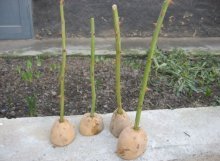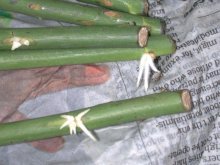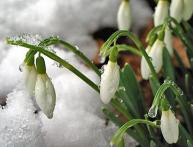The second life of a rose: growing roses from cuttings at home

How often housewives sigh when they send a wilted bouquet of beautiful roses to the trash bin. How I would like to see just such a bush blooming on my plot or balcony. No problem! A few recommendations from experienced gardeners, and roses More than once you will be pleased with a luxurious bouquet.
Content:
- Which roses should be rooted?
- How to properly prepare cuttings
- Rooting in water
- Rooting rose cuttings in the ground
- Rooting rose cuttings in potatoes and aftercare
Which roses should be rooted?
Unfortunately, there is no guarantee that all cuttings prepared for rooting will pass this stage successfully. Before rooting roses at home, you need to remember that:
- Dutch hybrid varieties of roses, like hybrids from South America, reproduce by cuttings extremely poorly - this is inherent in their physiology. You need to prepare a lot of cuttings; about 15% of them will take root in the soil.
- Dark-colored rose cuttings root much easier than roses with yellow and orange colors or shades.
- To root roses from a bouquet, it is better to select specimens in buds - faded roses are weakened.
- The buds should be clearly visible in the leaf axils.
For a better rooting process, long daylight hours are required. Therefore, rooting should begin in the spring, summer or early autumn or at home cuttings backlight If the desire to root rose cuttings has not disappeared, then it’s time to prepare the cuttings.
How to properly prepare cuttings
Not all roses provide good rooting material. From the bouquet you must immediately select flowers with a stem no thinner than a pencil. You also need to select the branches of the rose bush you like. You need to cut it with a sharp pruner. The selected branch must have at least 3 buds: the lower cut should be made between the buds along an oblique path, and the upper cut should be made directly above the bud (1 cm higher) and as horizontally as possible. Immediately treat the area of the upper cut with crushed activated carbon.
All leaves, except the top branch, must be torn off. Also carefully remove the thorns. If the cutting is prepared in this way, then it’s time to make the correct bottom cut: lower the lower part of the branch into water and make an oblique cut there. In this case, the air will not be able to “seal” the tubules of the barrel.
Cuttings can be rooted in different ways:
- In water
- In the ground in the greenhouse
- In potatoes
- Burrito method
Before rooting cuttings in any way, experienced home gardeners have been carrying out certain procedures for many decades.
Before rooting the cuttings, they are soaked for a day in a solution of baker's yeast: dissolve 250 grams of wet yeast in two liters of water. Then rinse and place in clean water. The cuttings should be half immersed in water. The remaining yeast water from soaking can be poured under other indoor plants - this is an excellent fertilizer and growth stimulator, thanks to the presence of B vitamins.
Honey has excellent antiseptic properties and contains a complex of mineral components, which activates growth and improves the health of cuttings. The solution for stimulating root growth is as follows: 2 tsp. natural honey per 3 liters of water at room temperature.Immerse the cuttings overnight in this solution to a depth of 1/3 of their length, and in the morning remove them and place them in a container with water for rooting. After familiarizing yourself with each one, you can choose an accessible and interesting method.
Rooting in water
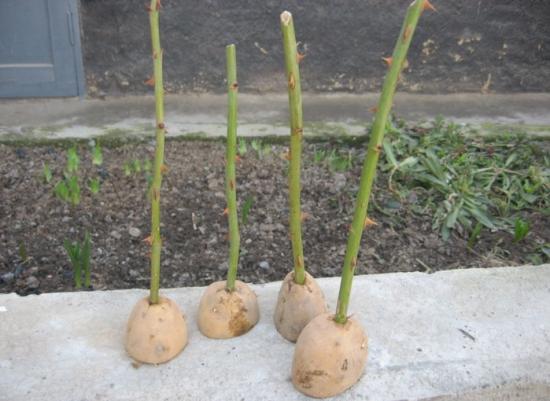
This is the simplest method, but the roots are weak and will require careful care for their further rooting in the soil. For rooting, you can use clean water with any root formation stimulator, or you can use folk remedies.
Aloe causes active cell division, so it is used not only as a growth stimulator, but also as an immunomodulatory agent. Before any use, it is better to wrap the aloe leaf in dark paper and put it in the refrigerator for a week. A few drops of fresh aloe juice are enough for a container with cuttings. The “willow water” method requires a little more effort and time, but gives excellent results.
In addition, the resulting product can be used repeatedly. To get “willow water” you need to place several willow twigs (or willow, poplar or wild rosemary) in a container with water and wait for their roots to appear, then remove the branches. This water is an excellent stimulator of root formation even in cuttings that are very greedy for roots. If during the rooting process water evaporates from the container, then fresh water must be added: this does not change the properties.
Rose cuttings will stand in water for quite a long time - about one and a half to two months. To speed up the process, you can put a transparent plastic bag with a small hole on the cuttings and tie it to the container - you will get a mini-greenhouse.
Old leaves may fall off and should be removed from the bag immediately.During the cold season, the constructed greenhouse must be placed in a warm place and lighting must be provided. When a white coating appears on the cuttings in the water, this means that roots will soon appear. The cuttings are transplanted into the ground when they reach a length of at least 1 cm.
For the rooting process to be successful, priming should be very loose: turf soil (2 parts), leaf soil and sand - one part each. The cuttings are planted to a depth of 1.5-2 cm and a 2-3 cm layer of sand is poured on top for better air access. For planting, you can use ordinary flower pots, but to control rooting it is better to take plastic transparent glasses (0.5 l), having previously made several holes in the bottom.
All planted cuttings are again watered with warm water with a root formation stimulator and placed in a greenhouse from a bag, but there is no need to tie it. After two to three weeks, the bag can be removed and the cuttings can be watered approximately once a week, preventing the soil from drying out.
Rooting rose cuttings in the ground
Cuttings are prepared for rooting as described above, but before planting in the ground, dip the lower end of the cutting in any rooting stimulant. Rooting soil can be purchased ready-made “For roses”, or you can use perlite. In the planting container, you need to organize good drainage - pour at least 2 cm of expanded clay onto the bottom.
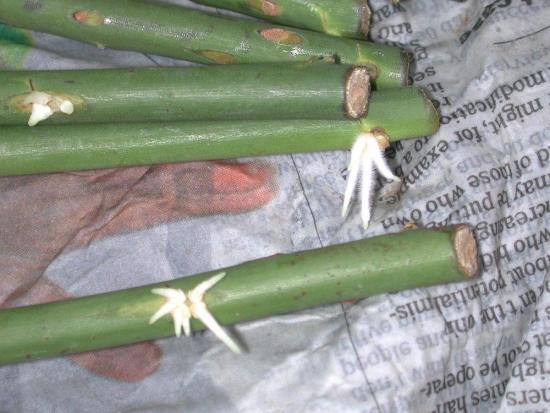
You can use ordinary pots as containers, but glasses made of transparent plastic are better - the size of the glass should be chosen depending on the size of the cutting: cuttings They go deep into the ground almost to the top bud, slightly at an angle.
After planting, the top soil should be sprinkled with a layer of sand to prevent fungal diseases.A greenhouse made of plastic bags must be built over the cuttings. The greenhouse should be preserved for a month or two; the emerging root system will be visible in the plastic cups, then the greenhouse can be removed.
Rooting rose cuttings in potatoes and subsequent care
Traditional gardeners suggest rooting roses in fresh potatoes: the nutrients will nourish the cuttings and stimulate the appearance of roots. The method is the simplest: simply insert the prepared cuttings into large potatoes at 2/3 of the height. The potatoes are dropped into a 5 cm deep pot, after removing all the eyes (otherwise the potatoes will grow their own shoots).
Burrito method
Gardeners have recently become familiar with this simplest method; it does not give high rooting results. All cuttings with the lower cut are dipped in any rooting agent and wrapped in damp newspaper in several layers. The bundle is placed in a cool place with a temperature of about 15 degrees for two weeks. It is necessary to regularly check and moisten the “burrito” during this time. After 14 days, unfold and select those cuttings that have formed a white coating - the place of future roots - for planting in the ground in the greenhouse.
Caring for rooted cuttings
Young rose bushes should be watered sparingly. In the first year of independent life in the ground, the buds of roses are cut off, which gives the plant the opportunity to gain strength and get stronger. And within a year the young rose will delight you with a beautiful bouquet.
Video about growing roses from cuttings:

